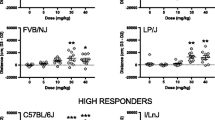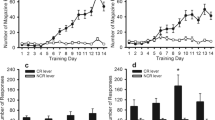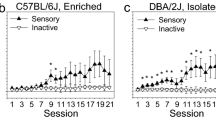Abstract
In experiment 1, two different strains of mice [C57BL/6J (B6) and DBA/2J (D2)] were allowed to nosepoke for 5 µl intravenous (IV) infusions during 2-h daily sessions. Two nosepoke holes were available, only one of which was reinforced on an FR-3 schedule with a 10-s time-out indicated by a light inside the reinforced nosepoke hole. During the first nine sessions, infusions were saline. On subsequent sessions, mice acquired nosepoking for 0.5 mg/kg cocaine. Finally, all mice were extinguished by again receiving only saline infusions. Cocaine acted as a reinforcer in both strains. In experiment 2, different mice from the same two strains were allowed to acquire nosepoking for IV cocaine at one of three unit doses (0.5, 1.0, or 2.0 mg/kg). Although there were no effects of unit dose on rate of acquisition, B6 mice were faster in acquiring self-administration behavior than were D2 mice. Experiment 3 assessed behavior in the same mice, after acquisition had occurred. D2 mice nosepoked at a lower rate at asymptote than did B6 mice, but with a higher preference for the cocaine reinforced hole. Unit doses of cocaine were then manipulated within subjects, from 0.125 to 2.0 mg/kg per infusion. Higher doses yielded lower response rates than lower doses, both between and within subjects. Behavior in D2 mice relative to B6 mice also appeared to be shifted to the left of the dose-response curve measured within-subjects. Together, these findings indicate that although cocaine serves as a reinforcer in both strains, there are genetic differences in the pattern of cocaine self-administration between these two mouse strains.
Similar content being viewed by others
References
Belknap JK, Belknap ND, Berg JH, Coleman R (1977) Preabsorptive vs. postabsorptive control of ethanol intake in C57BL/6J and DBA/2J mice. Behav Genet 7:413–425
Belknap JK, Coleman RR, Foster K (1978) Alcohol consumption and sensory threshold differences between C57BL/6J and DBA/2J mice. Physiol Psychol 6:71–74
Carney JM, Landrum RW, Cheng MS, Seale TW (1991) Establishment of chronic intravenous drug self-administration in the C57BL/6J mouse. NeuroReport 2:477–480
Crabbe JC (1989) Genetic animal models in the study of alcoholism. Alcohol Clin Exp Res 13:120–127
Crabbe, JC, Belknap, JK, Buck, KJ (1994) Genetic animal models of alcohol and drug abuse. Science 264:1715–1723
George FR, Goldberg SR (1988) Genetic differences in responses to cocaine. In: Clovet D, Asghar R, Brown R (eds) NIDA Res Monogr 88:239–249
Grahame NJ, Phillips TJ, Burkhardt-Kasch S, Cunningham CL (1995) Intra- venous cocaine self-administration in the C57BL/6J mouse. Pharmacol Biochem Behav 51:827–834
Katz JL (1989) Drugs as reinforcers: pharmacological and behavioural factors. In: Cooper SJ, Liebman JM (eds) The neuropharmacological basis of reward. Clarendon Press, Oxford, pp 164–213
McClearn GE, Rodgers DA (1959) Differences in alcohol preference among inbred strains of mice. Q J Stud Alcohol, 52:62–67
Meisch RA, Lemaire GA (1993) Drug self-administration. In: Van Haaren F (ed) Methods in behavioral pharmacology. Elsevier, Amsterdam, pp 257–300
Phillips TJ, Crabbe JC (1991) Behavioral studies of genetic differences in ethanol action. In: Crabbe JC, Harris RA (eds) The genetic basis of alcohol and drug actions. Plenum Press, New York, pp 25–104
Piazza PV, Deminiere JM, Le Moal M, Simon H (1989) Factors that predict individual vulnerability to amphetamine self-administration. Science 245:1511–1513
Piazza PV, Deminiere JM, Le Moal M, Simon H (1990) Stress and pharmacologically-induced behavioral sensitization increases vulnerability to acquisiton of amphetamine self-administration. Brain Res 514:22–26
Pickens R, Thompson T (1968) Cocaine-reinforced behavior in rats: effects of reinforcement magnitude and fixed-ratio size. J Pharmacol ExpTher 161:122–129
Schenk S, Davidson ES (1995) Stimulant preexposure sensitizes rats and humans to the rewarding effects of cocaine. NIDA Res Monogr (in press)
Seale TW (1991) Genetic differences in response to cocaine and stimulant drugs In: Crabbe JC, Harris RA (eds) The genetic basis of alcohol and drug actions. Plenum Press, New York, pp 279–321
Seale TW, Carney JM (1991) Genetic determinants of susceptibility to the rewarding and other behavioral actions of cocaine. J Addict Dis 10:141–162
Taylor BA (1972) Genetic relatedness between inbred strains of mice. J Hered 63:83–86
Wise RA (1987) Intravenous drug self-administration: a special case of positive reinforcement. In: Bozarth MA (ed) Methods of assessing the reinforcing properties of abused drugs. Springer, New York, pp 117–141
Wise RA (1989) The brain and reward. In: Cooper SJ, Liebman JM (eds) The neuropharmacological basis of reward. Clarendon Press, Oxford, pp 377–424
Yokel RA (1987) Intravenous self-administration: response rates, the effects of pharmacological challenges, and drug dependence. In: Bozarth MA (ed) Methods of assessing the reinforcing properties of abused drugs. Springer, New York, pp 1–33
Author information
Authors and Affiliations
Rights and permissions
About this article
Cite this article
Grahame, N.J., Cunningham, C.L. Genetic differences in intravenous cocaine self-administration between C57BL/6J and DBA/2J mice. Psychopharmacology 122, 281–291 (1995). https://doi.org/10.1007/BF02246549
Received:
Revised:
Issue Date:
DOI: https://doi.org/10.1007/BF02246549




